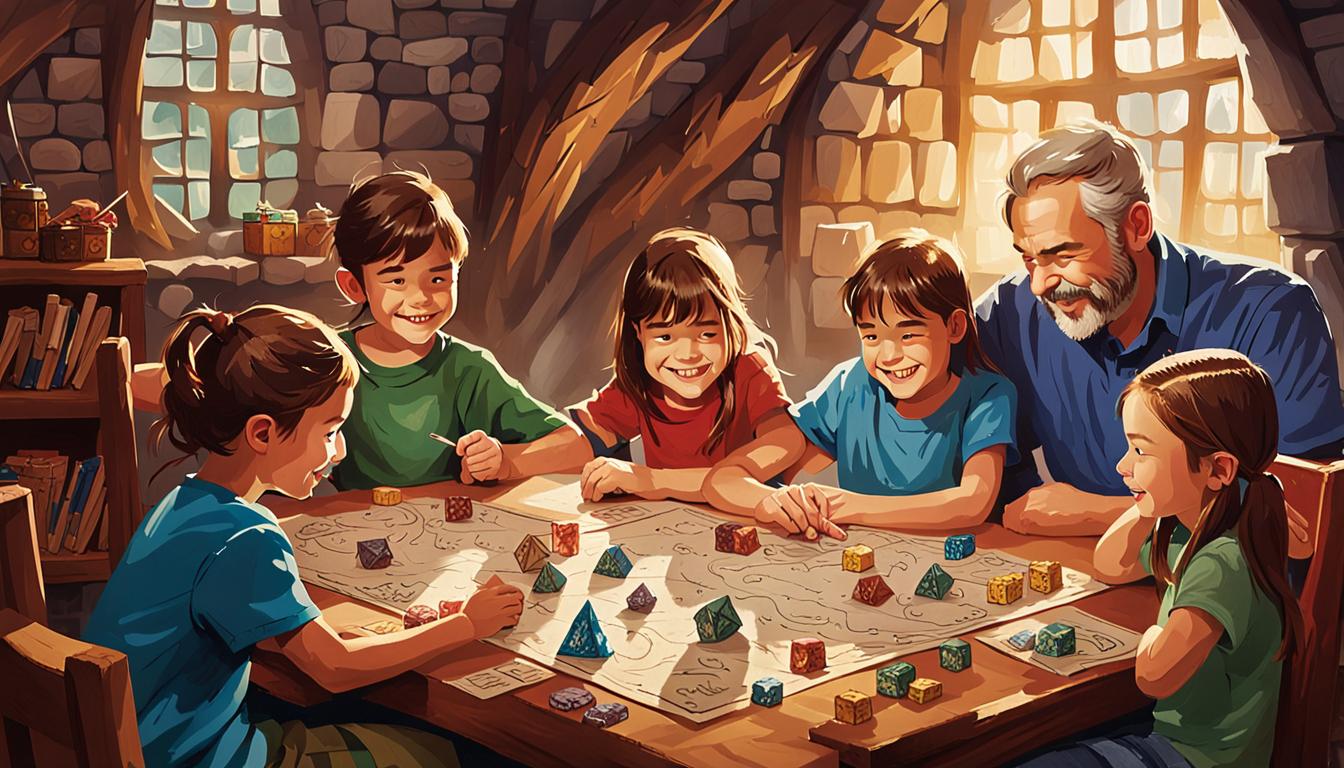
With my little nieces and nephews, great-nieces, and my own daughter, I've been playing "Kid D&D" for many years. Children have a natural bent for RPGs: "I'll be the genie and you be the prince," say, or "Pretend I'm Frodo and you're Gollum." But rolling dice to decide outcomes, having a "character sheet," and introducing concepts like hit points gets them moving from make-believe to real tabletop gaming.
Odds are, your kids know that you and your friends play these games, especially if they have heard you talk about your gaming or seen sessions in person. You can create interest by letting your kids play a "grown-up" game, hopefully so that they will grow to love gaming, like dad and mom. Let them do what they see you do -- though with but much simpler, kid-friendly rules and situations.
Another good way to spread the gaming bug is with sessions at your local library. If these are older kids, you can use the actual rules, for example with premade PCs they can reskin to make them their own. A good sessions for tweens might run a couple hours.
I asked some friends for their advice, and, based on that conversation, here are some tips to get you started.
- Make sure to incorporate actual roleplay! Act out the NPCs, and remember to do the voices!
- Emphasize puzzles and talking over fights the moment you sense your little players may be afraid of getting hurt.
- Let enemies surrender and promise to be good from now on. "Send the monster home." rather than "The monster falls dead screaming filled with barbed arrows."
- Ease them into adventures by giving them settings similar to those they already know. If your kids have been in a barn, set an adventure in one.
- The first couple times, whatever they want to try should have a positive outcome, even if it’s not exactly what they wanted. Positive reinformcement means a lot.
- Keep it very short. Think cartoon instead of movie. Short episodes or "clips," if you prefer, instead of an hours-long multiple scene module. Think 10-minute adventure to begin with. If it is taking you longer than 30 min to write what you want to do, you're probably doing too much!
- Feel free to ask each kid to name one or two things they want to do in their amazing adventure.
- Design your adventure for the youngest player. For example, 4 and 7 are very different ages, developmentally, as you parents will have seen. It is much easier for your 7 year old to "go back" to being a 4 year old than for your 4 year old to understand things for which her brain isn't yet ready.
- Wing it when you're playing. It is ok if you do not stick much to a theme (or even a coherent narrative) -- and this is for them, not you.
- Your goal is to create interest. So stick to what they like, not what you want to teach. You can add "educational content" after they are hooked.
- And the best for last -- It's a game -- make it fun!
For little kids, say 12 and under, you do not want to use published rules, or even "rules-light" versions you can sometimes get for free online. Making the rules simple to instill fun is very, very important. You want a very minimal ruleset that you can memorize and play effortlessly. For "character heets," keep it to the bare bones.
I used to play mini-adventures with the kids in my life using these mechanics.
With kids old enough to read, give each kid a "character sheet" that is an index card with their info.
Offer a limited choice of preset characters -- I would typically offer a rogue with a bow and arrow, a wizard with a wand, or a fighter with a sword and shield. Though I was also accommodating and allowed dragons, princesses, and unicorns, IIRC.
Ask each kid to come up with one word that describes their character: Brave, Strong, Fast, etc. That can be used to guide their actions. Give a greater chance of success when they try to do something that fits their word.
Let each kid have one special that they can do once per day. It can be whatever they want, and if they use it, they have a guaranteed success.
Whenever you want to do something, roll a d20. On a 10 or better, it works.
Every player starts with three pennies for hit points. All damage is subdual damage, and any hit costs a penny. When you lose your pennies, you are "tired" and get knocked out.
Also, each player has a quarter. You can spend your quarter once per adventure to do your special thing. The kid makes up the special thing, and it always works. You can allow better results for higher rolls and lesser for lower.
Keep it short, simple, fun. And in years to come, you'll have fresh new players for your own games!
(Art for this post created by AI through the Night Cafe website.)